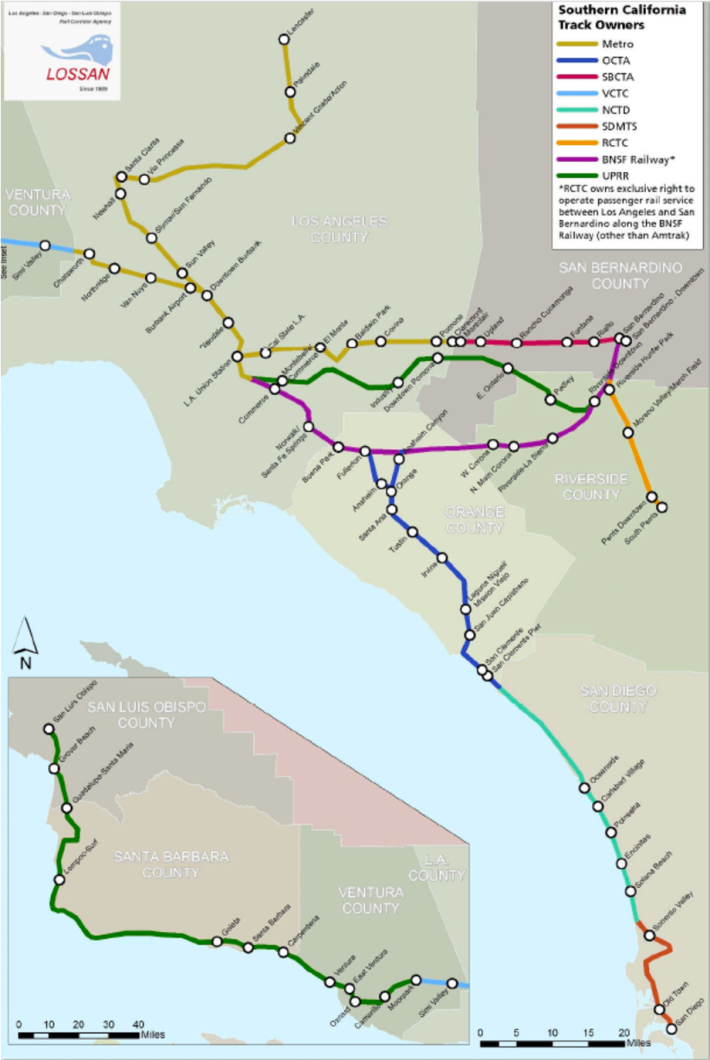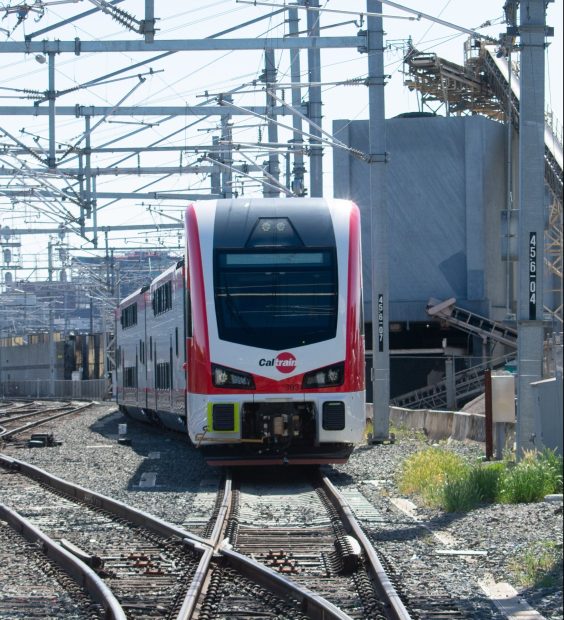Ten days ago, Caltrain launched its electrified service, to universal acclaim and glowing speeches by a who's-who of California politicians. On Monday, Californians for Electric Rail launched a petition calling on Metrolink to make an immediate commitment to overhead electrification following the success of Caltrain electrification. The petition received over 200 signatures in one day. KTLA wrote about the petition, and included an official response from Metrolink that they have no plans to electrify anytime soon. Here’s a rebuttal to some of their excuses.
Metrolink highlights that the more than 545 track miles in their system makes electrification infeasible. While we’d like to see all of Metrolink electrified eventually, we acknowledge that this would be a lengthy process. But our petition specifically calls for electrification only of the lines that would benefit most, that is Metrolink’s highest frequency lines that will be shared with high-speed rail (which will be powered by overhead wires): the Antelope Valley Line, San Bernardino Line, and portions of the LOSSAN corridor. Electrifying Anaheim-Vista Canyon and Union Station-San Bernardino would require a far more manageable 130 miles of overhead wire.
While these segments would benefit most from the higher traction power and faster acceleration of full wired electrification, Metrolink could also electrify even smaller segments, rolling them out systematically to eventually electrify the full system over a longer time frame. Battery-electric trains, which can charge in motion under wire and operate up to 100 miles off wire, would allow Metrolink to transition to zero emission rail sooner while rolling out an electrification program.
For instance, California High-Speed Rail trains will share tracks with Metrolink between Burbank and Los Angeles. While the project would be complex, as it requires other upgrades to allow high-speed rail trains to use it, Metrolink could partner with the High-Speed Rail Authority to complete this sixteen-mile segment early, helping ensure high-speed rail reaches Southern California. Alternatively, Metrolink could electrify the 49 miles on the Antelope Valley Line between Burbank and Vista Canyon. Completing these - or other simple segments on higher-frequency routes - would also increase Metrolink’s competitiveness for funding to electrify the whole system.
The KTLA article also states: “The price tag for electrification would be significantly higher than the $2.4 billion that Caltrain spent, which also included funding help — $700 million — from the California High-Speed Rail Authority.” This rests on the already debunked assumption that we are asking for a single initial investment ten times the length of Caltrain. In addition, Caltrain was one of the most expensive electrification projects ever, at $12.5 million/mile, due to a combination of avoidable mistakes in project management and delays caused by a frivolous CEQA lawsuit. Metrolink can keep costs lower by learning from Caltrain’s mistakes. And if Governor Newsom signs A.B. 2503 this month, he could also help cut costs by exempting Metrolink from the lawsuit risk Caltrain was subject to. The High-Speed Rail Authority has also already funded environmental impact reports for electrification of the Burbank to Anaheim route, further reducing costs for Metrolink.
KTLA also cites Metrolink’s lack of ownership of the right of way as an issue. All of the segments we call out in our petition are publicly owned, with the exception of Union Station-Fullerton, which is owned by BNSF. However, the High-Speed Rail Authority has already reached an agreement with BNSF to allow overhead wires on that segment, making this a non-issue.
The article touts Metrolink’s laudable use of Tier 4 locomotives, which are lower emission than older diesels, but electrification provides more benefits than just reduced emissions. The biggest benefit of electrification is the ability to replace car trips and reduce vehicle miles traveled (VMT). There is a documented “sparks effect” of increased ridership associated with electrification because the technology allows faster service. Cars contribute more to poor air quality and climate change than trains do, and CARB has mandated a twenty percent reduction in VMT by 2030.

Metrolink’s inaction on electrification is part of a larger pattern of disinvestment in frequent service. While Metrolink will see a modest service increase in October and is aiming for thirty-minute frequencies across the system by 2028 as part of its SCORE program, this is less ambitious than what Caltrain riders will see on September 21st thanks to electrification: fifteen-minute peak frequencies at fifteen stations, along with 25 percent faster travel times on local trains.
In its original genesis, Metrolink’s SCORE program called for fifteen-minute or greater frequencies and electrification on parts of the Antelope Valley, Ventura, and OC lines. But in the last seven years, the scope has been considerably reduced and there’s been no progress on electrification. Instead of committing to proven electric technology that synergizes with planned high-speed rail investments, Metrolink has (via SBCTA’s Arrow pilot) invested in hydrogen trains, a technology that is “best suited for longer, relatively low-frequency routes” - less than 48 trains per day (e.g. fifteen-minute peak service), according to the American Hydrogen Council. Rail agencies around the state are under heavy pressure from the Governor’s office and the hydrogen lobby to choose hydrogen trains. Transit advocates must step up the pressure in response, to prevent Metrolink from further investing in a rail technology that has repeatedly failed internationally.
Electrification of Metrolink will not happen in a day. But no progress can happen until Metrolink commits to electrification. Metrolink could use federal or state high-speed rail money - like Caltrain did - to fund electrification, but that’s off the table as long as the agency refuses to seriously plan for it. While Metrolink stalls, deadlines roll in. Scientists agree that greenhouse gas emissions (of which cars are the largest source) must be dramatically reduced by 2030 to avoid the worst effects of climate change. Metrolink must begin transitioning to zero emission trains by 2030, per CARB.
And with Brightine West high speed rail arriving in Rancho Cucamonga (but not Los Angeles, thanks to Metrolink) in 2028 and California High-Speed Rail in the Central Valley in 2030, the pressure on Metrolink to be high-speed-rail ready will only increase the more they wait. It’s going to take time to plan, secure funding, and build out the infrastructure for Metrolink - which is why the board needs to show some leadership now and commit to electrification today.
Find our petition to electrify Metrolink here.
Adriana Rizzo is a cofounder of Californians for Electric Rail. She lives in Riverside.






